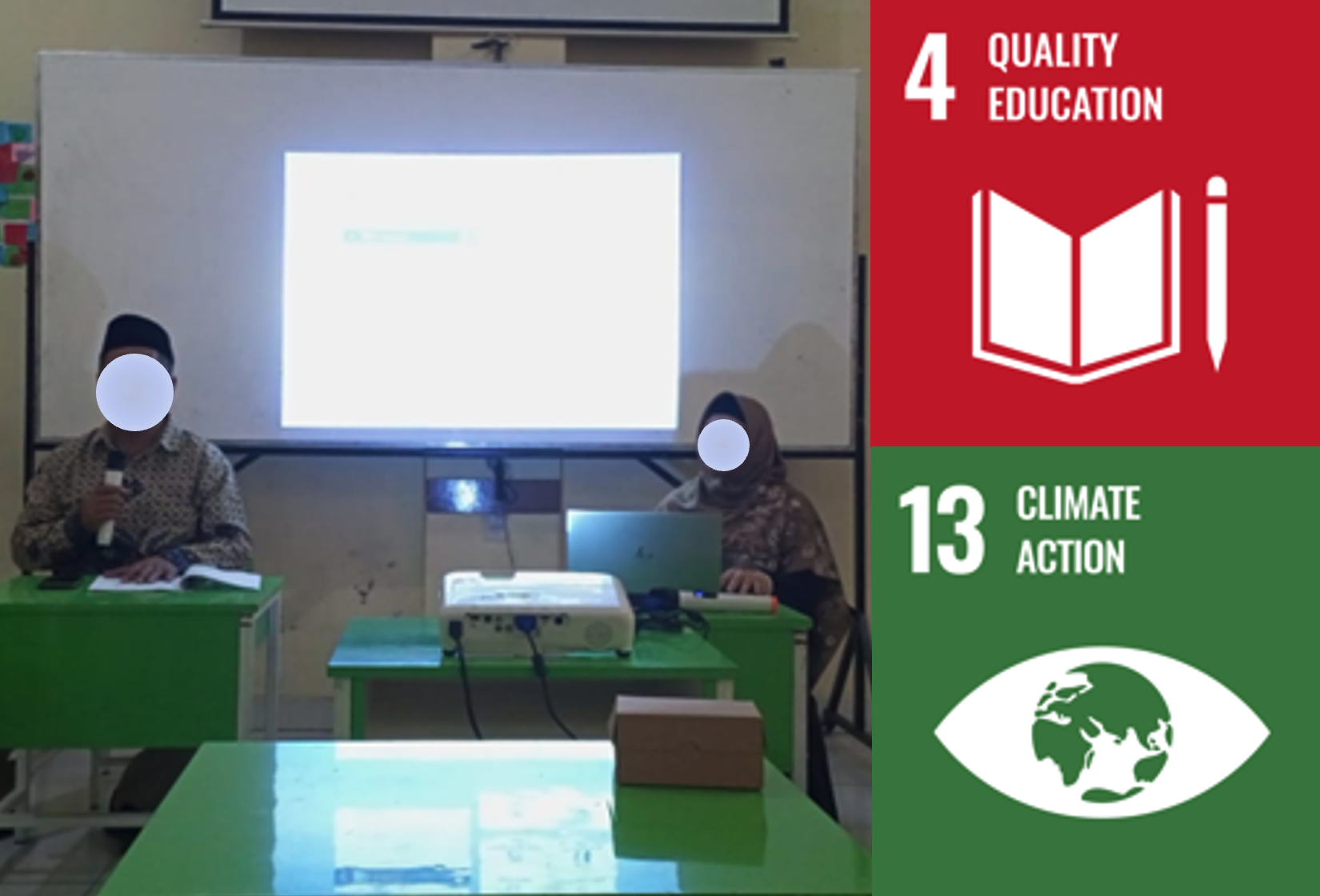Main Article Content
Abstract
In line with the focus on sustainable development, the government encourages the implementation of the green economy across various sectors, including educational institutions. This Community Partnership Empowerment Program (PKM) aims to assist SD Muhammadiyah 24 Surakarta in implementing the green economy through the Adiwiyata School initiative. The school faces several challenges, including limited green facilities, suboptimal waste management, and low environmental literacy. The PKM UMS team conducted an institutional strengthening program through socialization, workshops, and the application of technologies such as rainwater harvesting, groundwater tanks, and the design of a vertical garden with circular water. The implementation methods included socialization, training, mentoring, appropriate technology application, and evaluation. As a result, 80% of students have mastered environmental literacy, enabling them to internalize eco-friendly behaviors both at school and in their daily lives. Furthermore, support for the green economy was successfully implemented through the installation of rainwater harvesting systems, groundwater tanks, and vertical gardens utilizing circular water.
Keywords
Article Details

This work is licensed under a Creative Commons Attribution-NonCommercial 4.0 International License.
References
- Abdulla, F., Abdulla, C., & Eslamian, S. (2021). Concept and Technology of Rainwater Harvesting. In Handbook of Water Harvesting and Conservation: Basic Concepts and Fundamentals (pp. 3–16). https://doi.org/10.1002/9781119478911.ch1
- Annisa, B., Dewi, S. H., Harmiyati, Sherlina, V., & Sugeng, G. W. (2021). Peningkatan Partisipasi Masyarakat untuk Percepatan Capaian SDG’s Sektor Air Bersih dan Sanitasi. Dinamisia : Jurnal Pengabdian Kepada Masyarakat, 5(5), 1219–1225. https://doi.org/10.31849/dinamisia.v5i5.7860
- Azis, S. U., Nugroho, A. M., & Nikita, N. (2019). Konservasi dengan rain water harvesting system sebagai solusi efektif bagi bangunan sekolah. Jurnal Pengelolaan Lingkungan Berkelanjutan (Journal of Environmental Sustainability Management), 3(1), 258–271. https://doi.org/10.36813/jplb.3.1.258-271
- Čechová, K., Kunt, M., Vacek, O., Hendrych, J., & Jakubcová, E. (2022). Monitoring of selected plant taxa for vertical vegetation structures intended for use in urban environments. Clovek, Stavba a Uzemni Planovani - Man, Building and Urban Planning, 15, 80–107.
- Cristian, B., Mirabela, S. D., Elena, T. C., Marius, S., & Mihaela, M. (2019). Study on the possibility of building a vertical garden on the buasvmt faÇade. International Multidisciplinary Scientific GeoConference Surveying Geology and Mining Ecology Management, SGEM, 19(6.2), 549–556. https://doi.org/10.5593/sgem2019/6.2/S27.070
- Dorvlo, S. Y., Nyanteh, H. A., Aziato, E. K. S., Ninson, D., Dazugo, E., & Quaye, D. (2021). Effect of different soil depths on selected lettuce (Lactuca sativa) growth parameters in a developed self-watering vertical garden. Research on Crops, 22(4), 907–912. https://doi.org/10.31830/2348-7542.2021.148
- Gee, K. D. B., & Sojka, S. (2022). Maximizing the Benefits of Rainwater Harvesting Systems: Review and Analysis of Selected Case Study Examples. In Springer Water (pp. 77–117). https://doi.org/10.1007/978-3-030-95844-2_5
- Heryani, N. (2022). Pengembangan Teknologi Panen Air untuk Memenuhi Kebutuhan Domestik. Jurnal Sumberdaya Lahan, 15(2), 117. https://doi.org/10.21082/jsdl.v15n2.2021.117-129
- Ischenko, A., & Shishkunova, D. (2021). Application of vertical gardening technology in high-rise construction. E3S Web of Conferences, 258. https://doi.org/10.1051/e3sconf/202125809035
- Peraturan Menteri Lingkungan Hidup Republik Indonesia Nomor 5 Tahun 2013 tentang Pedoman Pelaksanaan Program Adiwiyata., Pub. L. No. 05, Lembaran Negara Republik Indonesia 2013 12 (2013).
- Kusumastuti, D. P., Kustanrika, I. W., Chairat, A. S. N., & Karmila, S. (2022). Panen Hujan Sebagai Sumber Air Alternatif Di Sekolah As Sholihin Cipondoh Tangerang. Abdimas Galuh: Jurnal Pengabdian Kepada Masyarakat, 4(2), 651–660. https://doi.org/10.25157/ag.v4i2.7344
- Kuswati, R., Waskito, J., & Achmad, N. (2024). Penguatan Kelembagaan melalui Sekolah Hijau Berkelanjutan. Prosiding University Research Collouquium, 172–180.
- McCullough, M. B., Martin, M. D., & Sajady, M. A. (2018). Implementing green walls in schools. Frontiers in Psychology, 9, 1–5. https://doi.org/10.3389/fpsyg.2018.00619
- Mulawarman, A., Munaja, R., Limung, & Kurniati. (2021). Potensi panen air hujan untuk pemenuhan kebutuhan air bersih di kawasan pendidikan Universitas Sulawesi Barat. Bandar: Journal of Civil Engineering, 3(2), 29–36. https://doi.org/10.31605/bjce.v3i2.1235
- Palanisami, K., Gemma, M., & Ranganathan, C. R. (2008). Stabilisation value of groundwater in tank irrigation systems. Indian Journal of Agricultural Economics, 63(1), 126–134. https://www.scopus.com/inward/record.uri?eid=2-s2.0-45249099310&partnerID=40&md5=a93a4ca70890a2dedf3d8c65c0eecd9a
- Primasasti, A. (2022). Urban Forest di Kota Solo. In Pemerintah Kota Surakarta.
- Rani, K. P., Srija, K., Jyothianvitha, A., Ashasri, M., Mamatha, I., & Rajesh, G. (2021). Rain water harvesting for smart water management using IoT. Proceedings - 5th International Conference on Intelligent Computing and Control Systems, ICICCS 2021, 475–478. https://doi.org/10.1109/ICICCS51141.2021.9432365
- Rofil, & Maryono. (2017). Potensi dan Multifungsi Rainwater Harvesting (Pemanenan Air Hujan) di Sekolah bagi Infrastruktur Perkotaan. Proceeding Biology Education Conference, 14(1), 247–251.
- Santos, W. C. D. V., Singh, D., da Cruz, L. D. L., Piassi, L. P. de C., & Reis, G. (2019). Vertical gardens: Sustainability, youth participation, and the promotion of change in a socio-economically vulnerable community in Brazil. Education Sciences, 9(3), 161. https://doi.org/10.3390/educsci9030161
- Singh, S., Yadav, R., Kathi, S., & Singh, A. N. (2022). Treatment of harvested rainwater and reuse: Practices, prospects, and challenges. In Cost Effective Technologies for Solid Waste and Wastewater Treatment (pp. 161–178). Elsevier. https://doi.org/10.1016/B978-0-12-822933-0.00003-6
- Sohailkhan. (2024). Vertical Gardens in Schools and Universities. In Green.
- United Stateds Environmental Protection Agency. (2024). Basic Information about Water Reuse. In EPA.
- Wagh, K. K., Ghuge, A. K., Gaidhane, D. N., & Gandhe, G. R. (2021). Design and Analysis of underground water tank by using Staad Pro. IRJET: International Research Journal of Engineering and Technology, 8(4), 4527–4532.
- Widati, W., Sulistyowati, F., Tyas, B. H. S., & Puspitasari, C. (2023). Pendampingan Pemanfaatan Air Hujan Sebagai Sumber Air Bersih Di Bantaran Sungai Code Kelurahan Wirogunan. SHARE: Journal of Service Learning, 9(2), 122–128. https://doi.org/10.9744/share.9.2.122-128
- Yingsamphancharoen, T., & Piriyakul, K. (2022). Feasibility study of steel reinforcement of polyethylene corrugated horizontal pipe for on-site underground water storage tanks and their applications. Case Studies in Construction Materials, 17, e01578. https://doi.org/10.1016/j.cscm.2022.e01578

